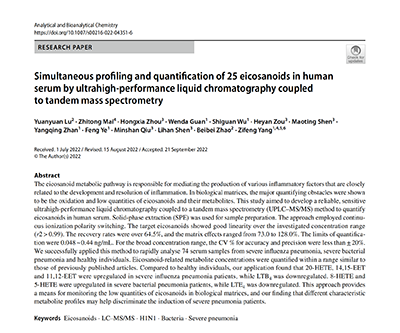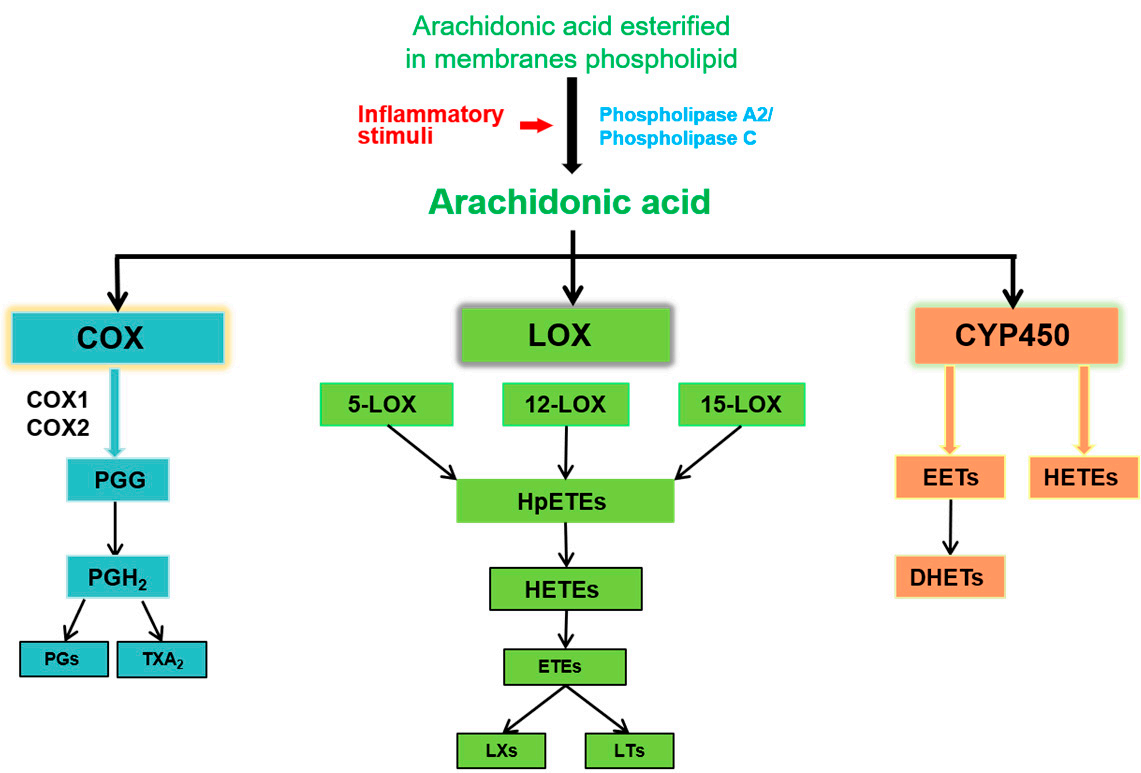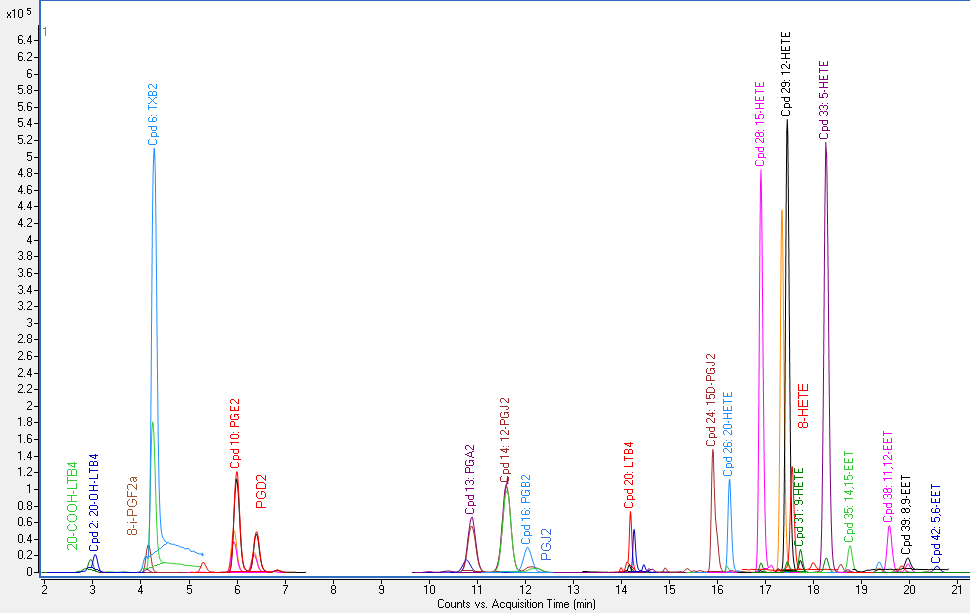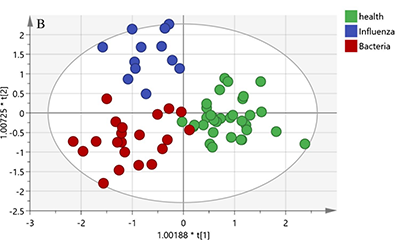Applied Research on Targeting Metabonomics Based on LC-MS/MS: An Effort to explore the Potential Biomarkers for Warning and Diagnosis of Severe Viral Pneumonia
2022-12-061003Recently, Guangzhou Institute of Respiratory Health, the SKLRD and the Guangzhou Key Laboratory of Rapid Clinical Diagnosis and Early Warning of Infectious Diseases have worked with the Dongguan Hospital Affiliated to Southern Medical University and Guangzhou KingMed Mass Spectrum Clinical Testing Center of KingMed Diagnostics to launch a research cooperation, established a method to carry out a quantitative test on 25 kinds of eicosanoid in the three major metabolic pathways of arachidonic acid in the serum at once with the LC-MS/MS technology and studied the correlation between the severe pneumonia caused by different sources of infection and the metabolic pathways of arachidonic acid through the targeting metabonomics based on LC-MS/MS, with an aim to mine the potential diagnostic biomarkers for the warning of severe viral pneumonia. The research findings were published in the international journal of “Analytical and Bioanalytical Chemistry” (IF=4.478).

Recently, the diseases caused by SARS, H1N1, H7N9, H5N6 and the latest Covid-19 have scattered, broken out and erupted worldwide. The condition of most patients has developed very quickly, which can develop within a short time into ALI/ARDS with serious symptoms such as breathing and circulatory failures and a fairly high fatality rate of (over 30% on average). The research indicates that the “cytokine storm” arising from the over-stress of the immune defense system of human bodies and the secretion of a lot of inflammatory cytokine is the primary threat that has triggered a severe pneumonia. The “cytokine storm” is a watershed for mild cases to develop into severe and critical cases as well as one of the causes of the deaths in severe and critical cases. Prediction in advance or a timely detection of the arrival of a cytokine storm is vital to the treatment of a severe pneumonia caused by a cytokine storm.

In the pulmonary alveoli as shown in the picture, the hyperactive immune response, also known as cytokine storm, has been recognized as the main cause of Covid-19 deaths. Source of the picture: Drug Discovery Today. Volume 27, Issue 2, February 2022, Pages 390-400
Currently, the common test indicators used in the diagnosis of infectious diseases, such as C-reactive protein (CRP), procalcitonin (PCT), serum amyloid protein A (SAA) and interleukin 6 (IL-6) are low in specificity for the diagnosis of severe viral pneumonia and the severity of the condition. Arachidonic acid (AA) is a kind of ω-6 polyunsaturated fatty acid, which is released from the phospholipid pool of the cell membrane when an inflammatory reaction occurs in the human body. Under the action of metabolic enzymes, Arachidonic acid is converted into bio-active eicosanoid acid in the three metabolic pathways of COX, LOX and CYP450. Eicosanoid acid plays an important role in the pathophysiological processes of many diseases, especially respiratory diseases and cancers. Previous studies show that AA metabolic pathway is closely related with the inflammatory reaction. Finding potential biomarkers of excessive inflammatory reaction from the AA metabolic pathway is of great significance in the exploration of its regulatory role and pathogenesis of the disease.

The metabolic pathway for the conversion of AA into eicosanoid acid
Source of the picture: Int. J. Mol. Sci. 2019, 20, 3683
For severe influenza pneumonia and severe bacteria pneumonia, the disparity index based on eicosanoid acid has not yet been confirmed so far. Finding the disparity index will help diagnose the pneumonia and estimate and monitor the development of the condition more accurately. With the aid of targeting metabonomics, this research analyzes the different characteristic metabolite profiles of the AA in the serum of healthy people and severe pneumonia patients with an Hyperinflammatory reaction caused by influenza virus or bacteria, which can help distinguish the severe pneumonia caused by different pathogens.
Since the concentration difference of eicosanoid acid in the bio-specimen can reach several orders of magnitude, the physical and chemical properties vary greatly among different types of compounds and there are many isomerides, the challenge is big to make an absolute quantitative analysis on the various components simultaneously. The LC-MS/MS testing method established by the team has adopted technical solutions such as sample pre-treatment with SPE method, dynamic MRM monitoring mode and the continuous switching mode of positive and negative ions so that the testing is highly sensitive, accurate and repeatable, which can ensure the accuracy and reliability of quantitative data obtained in the targeting metabonomics research in the metabolic pathway of AA.

Fig. 1 The extracted ion current of 25 kinds of eicosanoid acid
Through OPLS-DA analysis, there are significantly different metabolic expression patterns of AA among the healthy group, the group with severe influenza pneumonia and the group with severe bacteria pneumonia (Fig. 2). Compared with healthy individuals, the concentration of 20-HETE, 14 and 15-EET and 11 and12-EET rose and the concentration of LTB4 declined in the serum of patients with severe influenza pneumonia. The concentration of 8-HETE and 5-HETE both up-regulated among the patients with severe bacteria pneumonia, while the concentration of LTE4 down-regulated. Among all metabolites, the expression of TXB2 down-regulated in patients with severe pneumonia induced by influenza or bacteria (Fig. 3). The research finding is consistent with the conclusion reached by the model published by the Pernet team that LTB4 defective mice are easier to suffer a serious influenza infection. In addition, Schultz et all who have conducted a similar research have discovered that one day after the influenza infection, the concentration of 20-HETE in the lungs of mice has increased, while there was no obvious difference in the mice infected by bacteria.
By establishing a stable, reliable and sensitive UPLC-MS/MS method for the detection of AA metabolites, the research can conduct a quantitative test of 25 kinds of eicosanoid acid in the serum of humans at once and has adopted the targeting metabonomics to reveal that lipid mediator boosting and resisting to the inflammation is involved in the “inflammatory storm” within the body of severe pneumonia patients, which has provided another parameter support for better understanding the reaction of the host during the microbial infection.

Fig. 2 OPLS-DA analysis of the serum sample data of the healthy group, patients with severe pneumonia caused by H1N1 or bacteria

Fig. 3 Scatter diagram of eight significantly altered metabolites in the serum samples of the healthy group, the group with severe viral pneumonia and the group with severe bacteria pneumonia
The team led by professor Yang Zifeng from the SKLRD and the Guangzhou Key Laboratory of Rapid Clinical Diagnosis and Early Warning of Infectious Diseases have worked with Shen Lihan, director of the Dongguan Municipal Respiratory and Severe Disease Medical Research Institute of Dongguan Hospital Affiliated to the Southern Medical University and KingMed Mass Spectrum Clinical Test Center to carry out a research cooperation. The team led by professor Yang Zifeng is committed to the diagnosis, prevention and treatment research of respiratory tract virus and the ceaseless exploration in the research orientations of influenza virus and bacteria infection and has made important achievements by fully combining the basic and clinical medicine and applying the interdisciplinary areas such as virus, pharmacology and clinical medicine. The Dongguan Municipal Respiratory and Severe Disease Medical Research Institute is a medical center of severe diseases integrating clinical medicine, teaching and scientific research, which has been designated as a fixed-point receiving unit of severe and critical cases in Guangdong Province and Dongguan City.
By means of the metabonomics based on the LC-MS/MS technology, the cooperation project aims to find the potential biomarkers and later verify them by means of molecular biology, and study their regulating role in the excessive inflammation reaction caused by viral infection, so as to obtain systematic indicators that can accurately evaluate the occurrence and development status of clinical ALI/ARDS and enhance the successful diagnosis, warning, prevention and treatment of severe viral pneumonia cases.
Original paper:https://pubmed.ncbi.nlm.nih.gov/36344666/
















